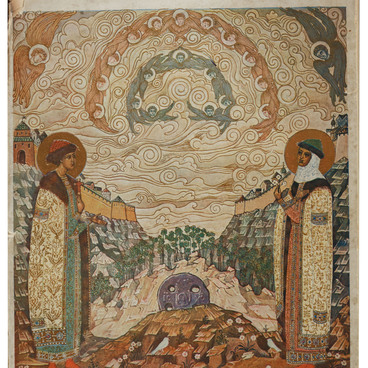The Bouillotte is a metal vessel with a lid, a tap or a spout. Originally bouillottes were used to heat water under field conditions, or as a vacuum flask as they sustained heat for a long time. Bouillottes appeared in Russia from Europe, and craftsmen in Tula set up the production thereof.
The Bouillotte
Creation period
1911
Dimensions
30x16x17 cm
30х16х17 cm
30х16х17 cm
Technique
Metal, wood, nickel plating
1
Open in app#1
The Bouillotte
#2
#3
The principle of operation of the Bouillotte is close to that of a samovar, however, is different with regard to the method of water heating. Inside the samovar there is a pipe and a charcoal fire-pan, while inside the Bouillotte there is a spirit burner. Hot water used to be poured into the vessel container, fire would sustain the required temperature, and drinks would be poured out through the tap or spout.
Samovars were usually set burning outside, and then were brought inside, which required a lot of time and effort. The Bouillotte was smaller in size and more convenient for use. In homes of aristocracy they were used in addition to samovars, to set the table. Boiling water from the samovar used to be poured into the Bouillotte and the latter was set on the table for a long tea-party.
#4
Some bouillotte models could perform the function of a coffee brewer: they had a small container for ground coffee inside. Four cups of coffee could be made in one go. In addition to tea or coffee, bouillottes were used to make hot mulled wine and punch. It was convenient to supervise the process through the glass lid, while heating rate was controlled with the burner.
#5
Due to the fact that the Bouillottes were used for table-setting and used to stay on the table during meals, they were made refined and ornamental. Many models were supplemented with exquisite arched legs and lids with carved decors. The handles had wooden components: those allowed to avoid burning fingers and served as additional decoration.
Bouillottes were made in various forms: conical, spherical, in the shape of a fire engine or a bird; such bouillottes were expensive. Shiny bouillottes for aristocracy were made of nickel bronze, silver or an alloy of a precious metal with copper. The more unusual the bouillotte looked, the more valued it was.
#6
In Russia, bouillottes were used through to the revolution. They used to be manufactured till 1917, and when the Bolsheviks came into power, ornate accessories disappeared as they were deemed to be an item of luxury.
#7
Sverdlovsk State Regional Ethnography Museum
read morehide
00:00
00:00
1x
The Bouillotte
Creation period
1911
Dimensions
30x16x17 cm
30х16х17 cm
30х16х17 cm
Technique
Metal, wood, nickel plating
1
Open in app
Share



